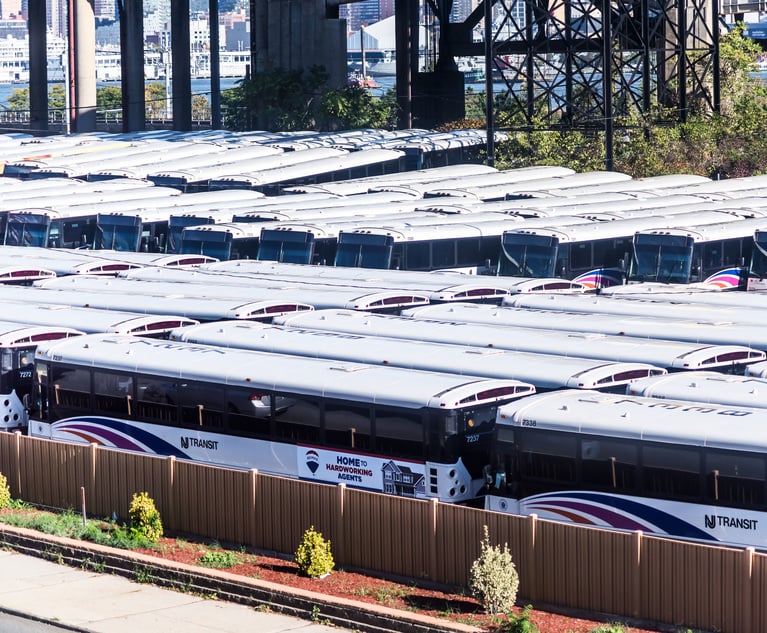
Lack of 'Proof of Notice' Sinks Pothole-Caused Injury Claim
"Because potholes are often not reported to the public entity before an accident occurs and it is difficult to prove how long they existed, it is very challenging for a plaintiff to prove that the public entity had either actual or constructive notice of the pothole," writes Betsy G. Ramos.
February 13, 2024 at 12:00 PM
5 minute read
Plaintiff Reginald Jones was injured when he was attempting to cross in the middle of Isabella Avenue in Irvington. While stepping off the curb, his foot became stuck in a hole in the street adjacent to the curb, which caused him to fall and suffer injuries. The issue in Jones v. Township of Irvington, 2024 N.J. Super. Unpub LEXIS 176 (App. Div. Feb. 6, 2024) was whether he could pursue a claim against the township for its failure to remediate the pothole.
Pothole cases against public entities are difficult to win due to the defenses available to public entities under the New Jersey Tort Claims Act. To be able to sue a public entity for tort liability for injuries caused by that entity's property, under N.J.S.A. 59:4-2, the plaintiff must establish the property was in a dangerous condition at the time of the injury and that the condition was either created by an employee of the public entity or the public entity had actual or constructive notice of the condition. However, even if the plaintiff is able to present those proofs, the public entity would not be liable for the dangerous condition of its property "if the action the entity took to protect against the condition or the failure to take such action was not palpably unreasonable."
Because potholes are often not reported to the public entity before an accident occurs and it is difficult to prove how long they existed, it is very challenging for a plaintiff to prove that the public entity had either actual or constructive notice of the pothole. These cases often fail due to the inability of the plaintiff to be able to prove notice and/or an inability to establish the existence of a dangerous condition at the time of the accident.
This content has been archived. It is available through our partners, LexisNexis® and Bloomberg Law.
To view this content, please continue to their sites.
Not a Lexis Subscriber?
Subscribe Now
Not a Bloomberg Law Subscriber?
Subscribe Now
NOT FOR REPRINT
© 2025 ALM Global, LLC, All Rights Reserved. Request academic re-use from www.copyright.com. All other uses, submit a request to [email protected]. For more information visit Asset & Logo Licensing.
You Might Like
View All

$2.85 Million Settlement Reached for Pedestrian Killed by Clifton Police Department Car
2 minute read

'Go 12 Rounds' or Settle: Rear-End Collision Leads to $2.25M Presuit Settlement
Law Firms Mentioned
Trending Stories
- 1Withers Hires Lawyers, Staff From LA Trusts and Estates Boutique
- 2To Speed Criminal Discovery, NY Bill Proposes Police-to-Prosecutor Pipeline For Records
- 3Merchan Rejects Trump's Bid to Delay Manhattan Sentencing
- 4High-Low Settlement Agreement 'Does Not Alone Establish Bias:' State High Court Affirms $20M Med Mal Verdict
- 5NYAG Preparing to Withdraw From Defense of Four Correction Officers' Federal Lawsuits
Who Got The Work
Michael G. Bongiorno, Andrew Scott Dulberg and Elizabeth E. Driscoll from Wilmer Cutler Pickering Hale and Dorr have stepped in to represent Symbotic Inc., an A.I.-enabled technology platform that focuses on increasing supply chain efficiency, and other defendants in a pending shareholder derivative lawsuit. The case, filed Oct. 2 in Massachusetts District Court by the Brown Law Firm on behalf of Stephen Austen, accuses certain officers and directors of misleading investors in regard to Symbotic's potential for margin growth by failing to disclose that the company was not equipped to timely deploy its systems or manage expenses through project delays. The case, assigned to U.S. District Judge Nathaniel M. Gorton, is 1:24-cv-12522, Austen v. Cohen et al.
Who Got The Work
Edmund Polubinski and Marie Killmond of Davis Polk & Wardwell have entered appearances for data platform software development company MongoDB and other defendants in a pending shareholder derivative lawsuit. The action, filed Oct. 7 in New York Southern District Court by the Brown Law Firm, accuses the company's directors and/or officers of falsely expressing confidence in the company’s restructuring of its sales incentive plan and downplaying the severity of decreases in its upfront commitments. The case is 1:24-cv-07594, Roy v. Ittycheria et al.
Who Got The Work
Amy O. Bruchs and Kurt F. Ellison of Michael Best & Friedrich have entered appearances for Epic Systems Corp. in a pending employment discrimination lawsuit. The suit was filed Sept. 7 in Wisconsin Western District Court by Levine Eisberner LLC and Siri & Glimstad on behalf of a project manager who claims that he was wrongfully terminated after applying for a religious exemption to the defendant's COVID-19 vaccine mandate. The case, assigned to U.S. Magistrate Judge Anita Marie Boor, is 3:24-cv-00630, Secker, Nathan v. Epic Systems Corporation.
Who Got The Work
David X. Sullivan, Thomas J. Finn and Gregory A. Hall from McCarter & English have entered appearances for Sunrun Installation Services in a pending civil rights lawsuit. The complaint was filed Sept. 4 in Connecticut District Court by attorney Robert M. Berke on behalf of former employee George Edward Steins, who was arrested and charged with employing an unregistered home improvement salesperson. The complaint alleges that had Sunrun informed the Connecticut Department of Consumer Protection that the plaintiff's employment had ended in 2017 and that he no longer held Sunrun's home improvement contractor license, he would not have been hit with charges, which were dismissed in May 2024. The case, assigned to U.S. District Judge Jeffrey A. Meyer, is 3:24-cv-01423, Steins v. Sunrun, Inc. et al.
Who Got The Work
Greenberg Traurig shareholder Joshua L. Raskin has entered an appearance for boohoo.com UK Ltd. in a pending patent infringement lawsuit. The suit, filed Sept. 3 in Texas Eastern District Court by Rozier Hardt McDonough on behalf of Alto Dynamics, asserts five patents related to an online shopping platform. The case, assigned to U.S. District Judge Rodney Gilstrap, is 2:24-cv-00719, Alto Dynamics, LLC v. boohoo.com UK Limited.
Featured Firms
Law Offices of Gary Martin Hays & Associates, P.C.
(470) 294-1674
Law Offices of Mark E. Salomone
(857) 444-6468
Smith & Hassler
(713) 739-1250






